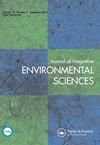Urban nitrogen budgets: flows and stock changes of potentially polluting nitrogen compounds in cities and their surroundings – a review
IF 3.5
4区 环境科学与生态学
Q3 ENVIRONMENTAL SCIENCES
Journal of Integrative Environmental Sciences
Pub Date : 2020-01-01
DOI:10.1080/1943815x.2020.1841241
引用次数: 4
Abstract
ABSTRACT Concepts of material flow and mass consistency of nitrogen compounds have been used to elucidate nitrogen’s fate in an urban environment. While reactive nitrogen commonly is associated to agriculture and hence to large areas, here we have compiled scientific literature on nitrogen budget approaches in cities, following the central role cities have in anthropogenic activities generally. This included studies that specifically dealt with individual sectors as well as budgets covering all inputs and outputs to and from a city across all sectors and media. In the available data set, a clear focus on Asian cities was noted, making full use of limited information and thus enable to quantitatively describe a local pollution situation. Time series comparisons helped to identify trends, but comparison between cities was hampered by a lack of harmonized methodologies. Some standardization, or at least improved reference to relevant standardized data collection along international norms was considered helpful. Analysis of results available pointed to the following aspects that would reveal additional benchmarks for urban nitrogen budgets: analysing the share of nitrogen that is recycled or reused, separating largely independent sets of nitrogen flows specifically between food nitrogen streams and fossil fuel combustion-related flows, and estimating the stock changes for the whole domain or within individual pools.城市氮预算:城市及其周边潜在污染氮化合物的流动和储量变化综述
物质流和氮化合物质量一致性的概念已经被用来阐明氮在城市环境中的命运。虽然活性氮通常与农业有关,因此与大面积有关,但在这里,我们根据城市在人类活动中普遍发挥的核心作用,汇编了关于城市氮预算方法的科学文献。这包括具体处理个别部门的研究,以及涵盖所有部门和媒介进出一个城市的所有投入和产出的预算。在现有的数据集中,注意到亚洲城市的明确重点,充分利用有限的资料,从而能够定量地描述当地的污染情况。时间序列比较有助于确定趋势,但由于缺乏统一的方法,城市之间的比较受到阻碍。一些标准化,或至少根据国际规范改进有关标准化数据收集的参考,被认为是有益的。对现有结果的分析指出了以下方面,这些方面将揭示城市氮预算的额外基准:分析回收或再利用的氮的份额,分离基本上独立的氮流,特别是在食物氮流和化石燃料燃烧相关的氮流之间,并估计整个领域或单个池内的储量变化。
本文章由计算机程序翻译,如有差异,请以英文原文为准。
求助全文
约1分钟内获得全文
求助全文
来源期刊

Journal of Integrative Environmental Sciences
ENVIRONMENTAL SCIENCES-
CiteScore
3.90
自引率
0.00%
发文量
13
审稿时长
>12 weeks
期刊介绍:
Journal of Integrative Environmental Sciences (JIES) provides a stimulating, informative and critical forum for intellectual debate on significant environmental issues. It brings together perspectives from a wide range of disciplines and methodologies in both the social and natural sciences in an effort to develop integrative knowledge about the processes responsible for environmental change. The Journal is especially concerned with the relationships between science, society and policy and one of its key aims is to advance understanding of the theory and practice of sustainable development.
 求助内容:
求助内容: 应助结果提醒方式:
应助结果提醒方式:


